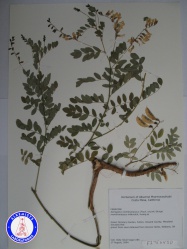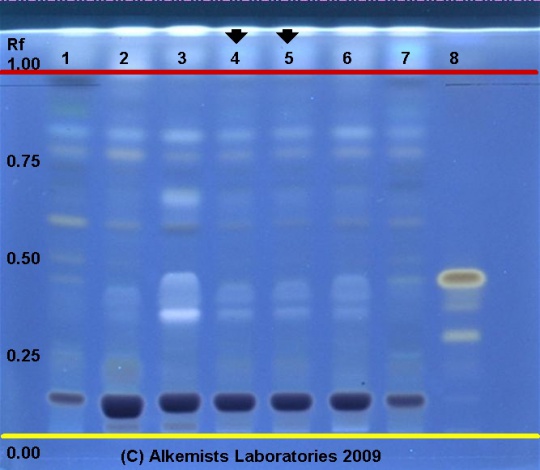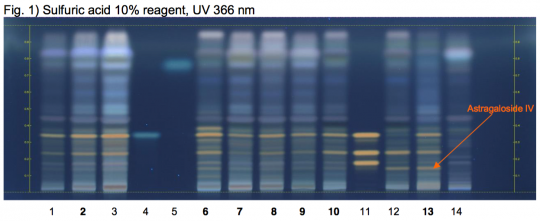Astragalus membranaceus (root)
(add askbox) |
|||
| (One intermediate revision by one user not shown) | |||
| Line 1: | Line 1: | ||
| − | {{DISPLAYTITLE:'' Astragalus membranaceus '' (root) }} | + | {{DISPLAYTITLE:'' Astragalus membranaceus '' (root) }} {{askbox|herb=''Astragalus membranaceus''}} |
=Nomenclature= | =Nomenclature= | ||
{{nomenclature | binomial=Astragalus membranaceus | {{nomenclature | binomial=Astragalus membranaceus | ||
| Line 111: | Line 111: | ||
=Supplementary Information= | =Supplementary Information= | ||
| − | = | + | =Sources= |
<references /> | <references /> | ||
Latest revision as of 17:32, 2 June 2014
Contents |
Nomenclature
Astragalus membranaceus (Fisch. ex Link) Bunge Fabaceae
Standardized common name (English): astragalus
Pinyin name(s): mo jia huang qi; huang qi (root)
Botanical Voucher Specimen
 |
|
Astragalus (flowering tops) (Astragalus membranaceus) Botanical Voucher Specimen - Alkemists Laboratories[1] |
Organoleptic Characteristics
Macroscopic Characteristics
Microscopic Characteristics
|
High Performance Thin Layer Chromatographic Identification
|
Astragalus (root) (Astragalus membranaceus) Lane Assignments Lanes, from left to right (Track, Volume, Sample):
Reference materials used here have been authenticated by macroscopic, microscopic &/or TLC studies according to the reference source cited below held at Alkemists Pharmaceuticals, Costa Mesa, CA. Stationary Phase Silica gel 60, F254, 10 x 10 cm HPTLC plates Mobile Phase chloroform: methanol: water [9/4/0.5] Sample Preparation Method 0.3 g + 3 ml CH3OH sonicate/heat @ 50° C ~ 1/2 hr Detection Method 5% Methanolic H2SO4 -> UV 365 nm Reference see American Herbal Pharmacopoeia & Therapeutic Compendium
|
|
Astragalus (root) (Astragalus membranaceus) Lane Assignments Lanes, from left to right (Track, Volume, Sample):
Reference Sample(s) Reference: Dissolve 1 mg of daidzin in 1 mL of methanol. Dissolve 1 mg of daidzein in 1 mL of methanol. Optional: dissolve 1 mg each of astragalosides I to IV individually in 1 mL of methanol. Stationary Phase Stationary phase, i.e. Silica gel 60, F254 Mobile Phase Ethyl acetate, methanol, water 100:13.5:10 (v/v/v) Sample Preparation Method Sample: Heat 3 g of powdered sample with 50 mL of methanol for 50 min under reflux, filter. Evaporate the filtrate under reduced pressure to dryness, take up the residue in 1 mL of water. Transfer this solution onto a 6 mL C18 SPE column (Bakerbond SPE C18 is suitable), that was conditioned with 3 mL of methanol and 3 mL of water. Wash the SEP column with 15 mL of water followed by 15 mL of 30% methanol. Discard both washings. Elute the sample with 20 mL of methanol and collect the eluate. Evaporate the eluate under reduced pressure to dryness, take up the residue with 2 mL of methanol. Derivatization reagent: Sulfuric acid 10% reagent Preparation: Solve 20 mL of sulfuric acid careful in 200 mL of methanol. Use: Dip (time 0, speed 5), heat at 100°C for 3 min Detection Method Saturated chamber; developing distance 70 mm from lower edge; relative humidity 33% Other Notes Images presented in this entry are examples and are not intended to be used as basis for setting specifications for quality control purposes. System suitability test: Daidzin: dark blue zone at Rf ~ 0.34; Daidzein: dark blue zone at Rf ~ 0.76 Identification: Compare result with reference images. The fingerprint of the test solution is similar to that of the corresponding botanical reference sample. Additional weak zones may be present. After derivatization the chromatogram of the test solution shows four orange zones corresponding to astragalosides I-IV between Rf ~ 0.15 and 0.35. The reference material daidzin and the reference material astragaloside I show more or less the same Rf value. In the upper part of the chromatogram several diffuse blue zones are present. One corresponds in color and position to daidzein at Rf ~ 0.76. Test for adulteration: Note: The chromatogram of Hedysarum root does not show orange zones at Rf ~ 0.23 and Rf ~ 0.33
|
Supplementary Information
Sources
- ↑ Botanical Voucher Specimen Library, Alkemists Laboratories
- ↑ Elan M. Sudberg, Alkemist Laboratories http://www.Alkemist.com
- ↑ Elan M. Sudberg, Alkemist Laboratories http://www.alkemist.com
- ↑ HPTLC Association http://www.hptlc-association.org/




